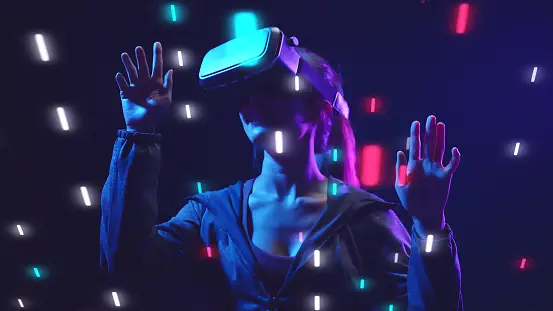Augmented Reality in Game Development
In the dynamic landscape of modern game development, augmented reality (AR) integration has emerged as a groundbreaking force, blurring the lines between the virtual and physical worlds. AR games have gained significant popularity in recent years. The release of Pokémon Go in 2016 served as a major catalyst for the widespread adoption and recognition of AR games. It quickly became a global phenomenon, capturing the attention of millions of players who ventured outside to explore their surroundings and catch virtual Pokémon using their smartphones. The success of Pokémon Go demonstrated the immense potential and appeal of Augmented reality in game, showcasing how they can blend the virtual and real worlds to create captivating and socially interactive experiences.
Table of Contents
What’s Augmented Reality in Game?
Think of augmented reality as a magic blend of real and make-believe. It’s unlike when you put on virtual reality goggles and disappear into a whole new world.
Instead, AR adds cool digital things to the real world. This happens using devices like phones, tablets, and special glasses. It’s like turning your world into a mix of real and fantasy.
Within this transformative realm, the unity game development company stands as a pioneer, harnessing the power of AR to craft immersive and captivating experiences that bridge reality and imagination.
How is augmented reality used in gaming?
Is augmented reality the future of videogames?
How AR Came to Games
Adding AR to games isn’t new. People started playing with it in the early 2000s, using it to make games more interesting. But the real “wow” moment came in 2016 with Pokémon GO.
Suddenly, everyone was hunting virtual creatures in their real neighborhoods. This showed how this tech could turn your everyday surroundings into part of the game.
Why Augmented Reality in Game Development Matters?
The use of augmented reality in game creation is important because it gives players access to new immersive and interactive experiences. They combine digital material with the player’s actual surroundings by superimposing virtual features on the real world, offering a distinctive and captivating gaming experience. AR games provide a multitude of gaming options, including location-based gameplay, interactive narrative, and social interactions. They do this by using the capabilities of contemporary smartphones or specialized AR devices. AR games make ordinary locations more intriguing by encouraging players to explore and interact with their surroundings, turning them into virtual playgrounds. Gamers now have an engaging and novel method to engage with digital entertainment thanks to the use of augmented reality (AR) technology in game production, which creates opportunities for creativity, innovation, and hitherto unheard-of game dynamics.
The use of augmented reality in game development has the potential to completely change how we view and interact with games, erasing distinctions between the virtual and real worlds. Examples of these uses include catching virtual creatures in the real world, solving puzzles superimposed on actual objects, and participating in multiplayer battles in shared augmented spaces.

Unity: Changing the Game with AR in Game Development
Unity is a super important tool for making games, and it’s a big deal in the world of AR. This tool lets game creators blend AR with the real world.
It’s like a magic bridge between the digital and physical. Unity makes it easy for game makers to mix the two together and create amazing experiences for players.
Making Amazing AR Games
Developers who use Unity can make games that mix reality and fantasy. They can make games where you interact with characters and objects in the real world. It’s not just about playing a game on a screen; it’s about being part of it.
Unity helps creators with tricky things like tracking movement and recognizing objects, so they can focus on making games fun.
Using AR in games isn’t always easy. There’s a lot to figure out, like how players will move around and how the game will work in different places.
But these challenges make things interesting for game creators. They have to think creatively to solve problems, which leads to cooler games.
The Exciting Future of AR Gaming
These games have a bright future. As technology gets better, the things we use for AR will become even cooler. This means more awesome games that mix real and fantasy.
Picture games that help you learn while having fun or that let you design buildings and see them in your neighborhood. The future is all about making gaming even more amazing.
FAQs
Q: Can I play Augmented Reality in Game without special stuff?
A: Yep, you can play lots of AR games on your phone or tablet. No need for fancy gadgets.
Q: Is Unity good for beginners?
A: Absolutely! Unity is user-friendly, and there are lots of guides to help beginners learn the ropes.
Q: What kinds of games benefit from AR?
A: AR can make many types of games cooler, especially adventure, puzzle, and simulation games.
Q: Are there privacy concerns with AR games?
A: Yes, because these games use real-world data, it’s important for game makers to think about privacy.
Q: How can I start making with Unity?
A: Unity has tutorials and tools to help newbies get started with making their own AR games.
Wrapping It Up: Future of Augmented Reality in Game
So, augmented reality has changed the way we play games. It makes them feel more real and exciting. And Unity, that powerful tool we talked about, has helped game creators make these awesome mixed-reality experiences.

11+ years strategic communications, marketing, and project management experience. I am a trainer at StarWood Training Institute, focusing on online courses for project management professionals.











